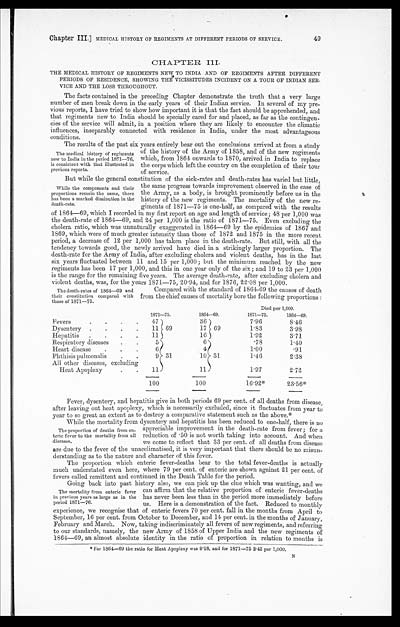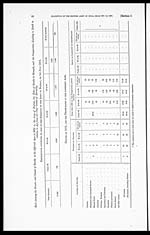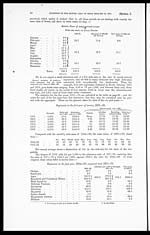Medicine - Institutions > Army health reports and medical documents > Vital statistics of India. Vol. V, Reports of 1876 on armies & jails and on epidemic cholera > Section I - General statistics of the British Army of India, 1871-76 > Chapter III - Medical history of regiments new to India and of regiments after different periods of residence, showing the vicissitudes incident to a tour of Indian service, and the loss throughout
(69) Page 49
Download files
Individual page:
Thumbnail gallery: Grid view | List view

Chapter III.]
MEDICAL HISTORY OF REGIMENTS AT DIFFERENT PERIODS OF SERVICE.
49
THE MEDICAL HISTORY OF REGIMENTS NEW TO INDIA AND OF REGIMENTS AFTER DIFFERENT
PERIODS OF RESIDENCE, SHOWING THE VICISSITUDES INCIDENT ON A TOUR OF INDIAN SER-
VICE AND THE LOSS THROUGHOUT.
The facts contained in the preceding Chapter demonstrate the truth that a very large
number of men break down in the early years of their Indian service. In several of my pre-
vious reports, I have tried to show how important it is that the fact should be apprehended, and
that regiments new to India should be specially cared for and placed, as far as the contingen-
cies of the service will admit, in a position where they are likely to encounter the climatic
influences, inseparably connected with residence in India, under the most advantageous
conditions.
The medical history of regiments
new to India in the period 1871—76,
is consistent with that illustrated in
Previous reports.
The results of the past six years entirely bear out the conclusions arrived at from a study
of the history of the Army of 1858, and of the new regiments
which, from 1864 onwards to 1870, arrived in India to replace
the corps which left the country on the completion of their tour
of service.
While the components and their
proportions remain the same, there
has been a marked diminution in the
death-rate.
But while the general constitution of the sick-rates and death-rates has varied but little,
the same progress towards improvement observed in the case of
the Army, as a body, is brought prominently before us in the
history of the new regiments. The mortality of the new re-
giments of 1871—75 is one-half, as compared with the results
of 1864—69, which I recorded in my first report on age and length of service; 48 per 1,000 was
the death-rate of 1864—69, and 24 per 1,000 is the ratio of 1871—75. Even excluding the
cholera ratio, which was unnaturally exaggerated in 1864—69 by the epidemics of 1867 and
1869, which were of much greater intensity than those of 1872 and 1875 in the more recent
period, a decrease of 12 per 1,000 has taken place in the death-rate. But still, with all the
tendency towards good, the newly arrived have died in a strikingly larger proportion. The
death-rate for the Army of India, after excluding cholera and violent deaths, has in the last
six years fluctuated between 11 and 15 per 1,000; but the minimum reached by the new
regiments has been 17 per 1,000, and this in one year only of the six; and 19 to 23 per 1,000
is the range for the remaining five years. The average death-rate, after excluding cholera and
violent deaths, was, for the years 1871—75, 20.94, and for 1876, 22.08 per 1,000.
The death-rates of 1864—69 and
their constitution compared with
those of 1871—75.
Compared with the standard of 1861-69 the causes of death
from the chief causes of mortality bore the following proportions:
| Died per 1,000. | ||||||
| 1871—75. | 1864—69. | 1871—75. | 1864—69. | |||
| Fevers | 47 | 69 | 36 | 69 | 7.96 | 8.46 |
| Dysentery | 11 | 17 | 1.83 | 3.98 | ||
| Hepatitis | 11 | 16 | 1.92 | 3.71 | ||
| Respiratory diseases | 5 | 31 | 6 | 31 | .78 | 1.40 |
| Heart disease | 6 | 4 | 1.00 | .91 | ||
| Phthisis pulmonalis | 9 | 10 | 1.46 | 2.38 | ||
| All other diseases, excluding Heat Apoplexy |
11 | 11 | 1.97 | 2.72 | ||
| 100 | 100 | 16.92* | 23.56* | |||
Fever, dysentery, and hepatitis give in both periods 69 per cent. of all deaths from disease,
after leaving out heat apoplexy, which is necessarily excluded, since it fluctuates from year to
year to so great extent as to destroy a comparative statement such as the above.*
The proportion of deaths from en-
teric fever to the mortality from all
diseases.
While the mortality from dysentery and hepatitis has been reduced to one-half, there is no
appreciable improvement in the death-rate from fever; for a
reduction of.50 is not worth taking into account. And when
we come to reflect that 33 per cent. of all deaths from disease
are due to the fever of the unacclimatised, it is very important that there should be no misun-
derstanding as to the nature and character of this fever.
The proportion which enteric fever-deaths bear to the total fever-deaths is actually
much understated even here, where 79 per cent. of enteric are shown against 21 per cent. of
fevers called remittent and continued in the Death Table for the period.
The mortality from enteric fever
in previous years as large as in the
period 1871—76.
Going back into past history also, we can pick up the clue which was wanting, and we
can affirm that the relative proportion of enteric fever-deaths
has never been less than in the period more immediately before
us. Here is a demonstration of the fact. Reduced to monthly
experience, we recognise that of enteric fevers 70 per cent. fall in the months from April to
September, 16 per cent. from October to December, and 14 per cent. in the months of January,
February and March. Now, taking indiscriminately all fevers of new regiments, and referring
to our standards, namely, the new Army of 1858 of Upper India and the new regiments of
1864—69, an almost absolute identity in the ratio of proportion in relation to months is
*For 1864—69 the ratio for Heat Apoplexy was 8.18, and for 1871-75 2.42 per 1,000.
N
Set display mode to: Large image | Zoom image | Transcription
Images and transcriptions on this page, including medium image downloads, may be used under the Creative Commons Attribution 4.0 International Licence unless otherwise stated. ![]()
| Permanent URL | https://digital.nls.uk/74993478 |
|---|




